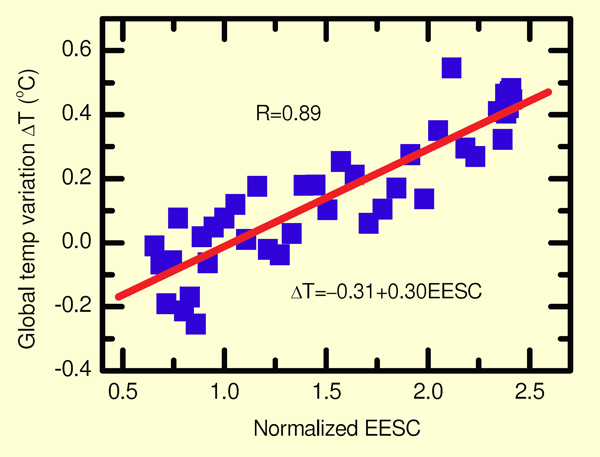Volume 13, Number 8: 25 February 2010
In an intriguing paper published in Physics Reports, Qing-Bin Lu -- who is associated with three different Departments at Canada's University of Waterloo (Physics and Astronomy, Biology, and Chemistry) -- injects a whole new dimension into the contentious debate over what has been the cause of late 20th-century global warming and its early 21st-century cessation.
The bulk of Lu's paper is dedicated to describing the new cosmic-ray-driven electron-induced reaction mechanism -- or CRE model -- of ozone depletion, which he contrasts with the conventional photochemical model of ozone depletion. Near the end of his discussion of this other important subject, however, he makes some original observations about the possible effects of chlorofluorocarbons (CFCs) and cosmic-ray-driven ozone depletion on global climate change, which subsidiary analysis gives one pause to wonder if the ire of the world's climate alarmists has long been focused upon the wrong greenhouse gas, i.e., CO2.
Lu begins by noting that ozone-depleting CFCs are also greenhouse gases, but that the IPCC has considered them to provide only about 13% of the total radiative forcing produced by all of the atmosphere's well-mixed greenhouse gases. He then goes on to challenge the low value of this assessment, stating emphatically (as indicated by his use of italics) that "these conclusions were based on climate model simulations rather than direct observations." And he thus proceeds to consider some real-world measurements in ways that have not been done before.
In plotting yearly mean global temperature deviations (ΔT, relative to the 1980 mean value) vs. equivalent effective stratospheric chlorine concentrations (EESC, normalized to the 1980 value) over the period 1970-2008, for example, Lu found that the former parameter was a well-defined function of the latter, as may be seen in the figure below, where the correlation coefficient (R) of the linear relationship between the two parameters is 0.89 at a probability level (P) of < 0.0001.

Figure 1. Yearly global temperature relative to its 1980 value (ΔT) vs. yearly EESC normalized to its 1980 value. Adapted from Lu (2009).
Of course, correlation does not prove causation, as climate skeptics are fond of saying about the similar relationship between ΔT and the air's CO2 content over the latter part of the 20th century. But Lu makes a point of noting that following the implementation of the Montreal Protocol, the total halogen level in the lower atmosphere was observed to peak in 1994 and the EESC over Antarctica was estimated to peak around the year 2000, after which it actually began to decline, as did global temperature, as shown in the figure below. And based on the estimated trend of EESC over the next four decades, Lu's analysis suggests that the earth may well continue to cool -- as it has been gradually doing for the past decade -- until the middle of the current century or more.

Figure 2. Yearly global temperature relative to its 1980 value (ΔT) and yearly EESC normalized to its 1980 value vs. time. Adapted from Lu (2009).
As for what it all means, Lu states, in the concluding paragraph of his lengthy treatise, that the "observed data point to the possibility that the global warming observed in the late 20th century was dominantly caused by CFCs, modulated by CRE-driven ozone depletion," and that "with the decreasing emission of CFCs into the atmosphere, global cooling may have started since 2002."
Like the good scientist that we presume he is, however, Lu does not contend that this must be the case; he only states that "this is likely a subject deserving close attention."
The question now is: Will other scientists provide that close attention? With all that is riding on the issue, we sincerely hope that they will.
Sherwood, Keith and Craig Idso
Reference
Lu, Q.-B. 2009. Cosmic-ray-driven electron-induced reactions of halogenated molecules adsorbed on ice surfaces: Implications for atmospheric ozone depletion and global climate change. Physics Reports 487: 141-167.




